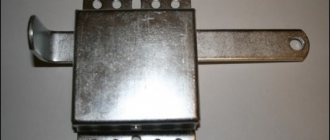Many motorists are forced to think about how to heat the engine sump with their own hands due to the weather conditions in winter, which affect the normal starting of the engine. Some drivers mistakenly believe that in winter it is difficult to start the power unit due to weak battery power. In fact, the problem is caused by a change in the lubricant, which becomes very viscous, making it difficult to start the engine and the functionality of the crankshaft.
Ineffective lubrication in the initial minutes of engine start leads to excessive wear of the piston unit. These troubles can be avoided by heating the crankcase and eliminating excessive oil viscosity.
Do-it-yourself 220V engine heating
According to experts, every person who understands car systems can assemble such a device on their own. So, he will need some details:
- basic spare parts for the heat exchanger;
- plates, which are then welded inside to increase heat exchange;
- a welding machine to weld seams that will become airtight;
- sheet asbestos, which is needed for thermal insulation of the device;
- asbestos liners, which eliminate the effect of the spirals closing on the body;
- a “nichrome” spiral for embedding it inside the device;
- additional heating elements;
- studs, each at least 25 millimeters, to tighten the covers;
- sealed material to secure the already assembled heat exchanger;
- peneplain, designed to wrap around the outside of the structure for complete thermal insulation;
- relays that are needed to avoid draining the battery;
- toggle switches that appear on the side of the center consoles to turn them on.
In some cases, in order for the procedure to proceed correctly and quickly, you can additionally use antifreeze.
12V antifreeze heater
Before installing and connecting a 12-volt antifreeze heater to a vehicle, the following conditions must be considered:
- A rechargeable battery is required for power; the heating system is connected directly to it. In the winter season, due to low temperatures, the device discharges faster, so the power supply system of the device can be supplemented with a transformer.
- The contact elements on the blocks and wires must be reliably insulated to prevent possible current leakage and short circuits.
- To increase the service life of cables, electrical circuits can be additionally wrapped with electrical tape.
What will be needed for production?
To build a gasoline or diesel heater yourself, you will need:
- two steel pipes (the diameter of one should be 80 mm and its thickness 1 mm, the dimensions of the second depend on the dimensions of the machine’s cooling system pipes);
- two heaters (you can purchase or make your own);
- set of cables for connection;
- a fuse that will prevent a short circuit (10 amperes);
- toggle switch for turning the heating system on and off;
- welding equipment or soldering station with consumables;
- metal scissors;
- Bulgarian;
- steel sheet 1 mm thick.
Manufacturing stages
At the next stage, you need to make a heating system, for which you will need a nichrome thread. Two thick pieces are pre-cut from paronite. The length of the spiral, as well as its diameter, do not matter, but its resistance should be in the range of 2.5-4 Ohms. If the segment is too short, it will burn when exposed to elevated temperatures. The wire is fastened using screws with 3 mm nuts. These components must be tightened as tightly as possible to ensure good contact and prevent wire burnout.
Then you need to build a heat exchanger; when performing the task, you need to take into account the following nuances:
- Welding is carried out with a body or gas welding machine; you will have to work with thin metal. You can use a soldering iron, but you will have to ensure the highest melting temperature.
- To achieve the highest exchange area, two plates are welded to the inner surface. These elements must be placed perpendicular to the pipes from which the refrigerant comes.
- After completing the welding work, you need to check the tightness of the assembled heater.
| Image | Action |
| |
| The next step is to build two plugs. These components are cut from a sheet of steel (you can use, for example, a tin can). The diameter of each plug must be 8 cm and the thickness must be at least 1 mm. You also need to make two lids, their size should be larger. | |
|
Heating - oil
Mazda tribute
Heating of the oil in the engine crankcase is carried out using a coolant or by electrically heating the bottom of the crankcase through an air cushion.
Heating the oil in oil tank switches is an important means of increasing their reliability at low temperatures. An analysis of the speed of movement of the contacts at different oil temperatures showed that at temperatures above O C the speed of movement remains practically constant. At temperatures from 0 to - 20 C the speed decreases, but at - 20 C it still seems acceptable.
The oil is heated to a temperature of 70 - 80 C, the oil is regenerated for up to 15 days, as a result its properties are restored, according to analysis, the flash point rises to 170 - 180 C, and the viscosity rises to 20 - 20 5 and the oil is subsequently used. Since the introduction of this system, about 15 tons of turbine oil have been restored and there is no longer a shortage of it at the compressor station.
Oil heating is carried out by electric heaters, the heating elements of which are mounted in circulation tanks or engine trays and are powered by electric batteries, or by special starting heaters - boilers that warm up the cooling system and run on the same fuel as the engine.
The oil is heated by electric current or hot air. The second method is preferable for equipment located outdoors. In addition to the usual use of hot air as a coolant in a special starting air heating system for the oil tank and oil coolers, hot air can be supplied directly to the apparatus and pipelines of the oil system and to the bearings of the units. This will prevent the occurrence of oil plugs, which can occur at very low outside temperatures. To prevent corrosion of the internal cavities of pipelines and especially the rotor journals, the air must be pre-dried. In some cases, it is advisable to add a sprayed inhibitor, such as dibutyl phthalate, to hot air, which increases the corrosion resistance of steel parts.
Heating the oil in the coarse filter with a coil increases the throughput of the filter when operating on cold oil.
The oil in the tanks is heated by steam passed through a coil. To maintain the required pressure in the oil line of the system between the pump and the oil tank, a pressure reducing valve is turned on.
Heating oils by fire or electricity, especially when preparing a mixture of winter oils with tractor kerosene, must be done in tanks with a water jacket.
Oil heating must be done in special water-oil heating tanks. Heating oil over an open fire is strictly prohibited.
The oil in the engine crankcase is heated using a coolant or by electrically heating the crankcase bottom through an air cushion.
Oils are heated: transformer oil up to 60 - 70 C; turbine up to 70 - 90 C; industrial up to 100 C. When cleaning oils without heating, the contact time should be increased.
The oil is heated using heating elements with automatic temperature control.
| Quenching tank. |
Heating of oil in quenching tanks is carried out using radiation gas, electric pipes or electric heaters located in the tank. To cool the oil, oil coolers are used, both located outside the tank and placed inside.
It is prohibited to heat the oil in the oil system of a gas turbine drive with an open fire. The power plant premises must be equipped with an automatic volumetric gas fire extinguishing system.
Engine 1.8/16. Crankcase gas tube heater (elimination of oil emissions in winter)
Citroen Xsara Picasso 1.8 petrol, 6FZ engine. It was also installed on a Peugeot 406. After the engine was filled with oil, I installed a pressure relief valve in the oil filler plug (described in the topic: Winter problems, solution). It helped, there were no more oil emissions. But after winter there was oil on the seal above the oil filler plug, i.e. the valve was triggered due to freezing of the breather. I replaced the throttle valve in a plastic casing with a throttle valve in an aluminum casing with an installed heater (bought used from disassembly). The problem of the damper hanging due to ice has disappeared (you let off the gas, and the engine roars). I read on the forum that there was a recall company for Citroens with the replacement of the crankcase exhaust pipe with a new one with heating. I tried to find them, but there aren't any at the disassembly sites. I decided to take up the collective farm and install the heater myself. I found a stainless steel tube of suitable diameter: outer diameter 14, inner diameter 12 mm. Length 130 mm. Both sides were machined to a diameter of 13 mm in order to be inserted with an interference fit inside the plastic gas exhaust tube (its internal diameter is 12.5 mm). The tube may be of a different length and made of a different metal. Then I wrapped the uncut part of the tube with mica tape for insulation, optionally with fiberglass and thermal tape (orange, sold in radio stalls). On top of the insulation, retreating 10-15 mm. I wound the heater with tension with nichrome (0.4 mm in diameter). To ensure a gap between the turns, I used winding in two wires with a single-core copper wire with a diameter of approximately 0.23 insulation (you can use fishing line, etc.). After securing the ends of the heater, the copper wire was removed. There was a gap between the turns of nichrome. The conclusions were made using a wire in heat-resistant insulation. On top of the nichrome I again wrapped two layers of mica and then thermal tape. Select the length of the nichrome thread by measuring with an ohmmeter. I couldn’t find out the power of the factory version. I wound the heater with a resistance of 20 ohms. This is approximately 10 watts with a 14 volt supply. Maybe not enough. The heater temperature is approximately 50-60 degrees. The throttle heater resistance is 9 ohms, which is approximately 23 watts. but there are also larger throttle valve sizes.
Remove the plastic engine cover. We remove the crankcase exhaust pipe by releasing the latch on the valve cover and two latches on the throttle valve. Next, we cut out a piece of the gas exhaust tube (it is not corrugated) 100 mm long, which we replace with a heater. We insert it by heating the end of the tube, for example in hot water. We first slide a piece of heat shrink of the required diameter and length onto the gas exhaust tube, which we then slide onto the heater. We connect the heater leads parallel to the yellow connector of the throttle valve heater through a pair of connectors purchased at a radio shop.
Last picture: repair of a cracked factory crankcase exhaust pipe with a heater, Peugeot 406, 1.8, found on the Internet at DRIVE.RU Peugeot 406 1.8 - Logbook - Crankcase ventilation pipe
Price for heating the engine 220V
Homemade pre-heater for a VAZ car engine
If you are sure that you will not construct an engine heater from a 220 volt network, then you will have to look for it on modern Internet resources. You can also find it on the automobile market, where you may find options according to your preferred price criteria.
When choosing heaters through online stores, it is better to find an option directly from the manufacturer. This is beneficial, because the pricing policy from the manufacturer is lower.
The price varies depending on what make and model of car you are looking for this device for, what brand and power you need it. Their approximate cost will vary from 1500 to 2500 rubles.
The best preheaters for passenger cars
Preheaters for passenger cars are presented in a large assortment; let’s look at the most popular models of 2018.
WEBASTO Thermo Top Evo Comfort+
The Webasto T400vl heater is designed specifically for the Russian market. A distinctive feature is the ability to warm up not only the car engine, but also create a comfortable temperature in the cabin.
WEBASTO Thermo Top Evo Comfort+
The power of the Webasto brand unit is 5 kW, which is enough for normal operation on gasoline engines with a displacement of up to 4 liters. The delivery set does not include a standard control unit.
Maximum efficiency is achieved by higher coolant temperatures, early start of the adp5 fan, faster heating thanks to liquid pump control and better heat transfer.
Operating instructions WEBASTO Thermo Top Evo Comfort+
Severs 103.3741
Severs is a budget energy-dependent heater that operates from a standard electrical network. The package includes a thermostat that protects against engine overheating. Heating to 60°C is carried out in 1-1.5 hours. At a temperature of 85°C the system stops working. If the coolant temperature drops to 50°C, the heater starts working again. It is noteworthy that the heater is protected from moisture and electric shock.
Severs 103.3741
The only downside of Severs is that it needs an outlet, so such a device can only be used if there is an electrical outlet.
Operating instructions Severs 103.3741
Defa Warm Up Warm Up 1350 Futura
DEFA WarmUp 1350 wFutura is the maximum system for pre-heating the engine, interior and charging the car battery. The system is controlled via the Futura mini-timer.
Defa Warm Up Warm Up 1350 Futura
The kit includes:
- electric cabin heater with a power of 1.3 kW;
- battery charger MultiCharger 1203 12 V, 3 A;
- Futura salon mini timer;
- set of power cables;
- set of connecting cables.
The big advantage is that the device consists of module blocks and armored connecting cables. Optionally, they can be installed either as separate blocks or as a whole complex.
Operating instructions Defa Warm Up WarmUp 1350 Futura
Some nuances
UAZ on tracks
A few details about the features of using both types of heaters. If you take a regular passenger car, the volume of lubricant and coolant is not much different (on average, 3.5 liters of oil are poured, and 4.5 liters of antifreeze). That is, theoretically, approximately the same energy will be required to heat both liquids. But there is one nuance - the oil is in one place - the pan, and the antifreeze is located throughout the system. Therefore, in the case of using a device for heating the coolant, circulation is required, but when heating the oil this is not necessary.
And one more thing - the antifreeze needs to be heated quite strongly (at least to 50-60 degrees), but the oil does not require this; you can only slightly increase its temperature to increase fluidity.
Due to these features, it is not advisable to use a 12-volt heater to heat antifreeze, since proper heating will require a lot of energy. Therefore, autonomous devices are mainly used to influence the lubricant, but those operating from a 220 V network are installed in the cooling system.
Next, we’ll look at how to make a pre-heater with your own hands for a VAZ or any other car. Note that there are a lot of variations of homemade devices, but we will describe only two devices that are relatively easy to manufacture.
Autonomous heater
A fairly common device for warming up the engine sump. The autonomous version is capable of processing decent volumes of air, consumes little energy and is practically silent. The unit can be installed with your own hands, both in the power supply system and in the cooling circuit of the car, regardless of the engine type. The source of energy in this case is the gas tank.
The autonomous crankcase heating model is a small chamber containing a fuel-air mixture, which is ignited using a special pin. Coolant circulates stably in the walls of the tank, the heating of which is provided by the pump. The warm mixture enters the car's small cooling circuit, warming up the engine.
Installation of this unit consists of connecting the heat exchanger of the heater to the small cooling circuit of the car, and the electrical part of the device to a similar system of the car.
When is heating required?
In the winter cold, every car owner, when a problem arises, thinks about how to quickly start and drive, so as not to be late for work or other necessary places. Most likely, in everyone's life there has been a situation when the car failed at an unexpected, unnecessary moment. Therefore, the task becomes the correct installation of an autonomous homemade oil heating device.
If you are interested in this issue, then know that the serviceability of the mechanisms in the car and the installation of such heating will allow you to:
- quickly and easily start the units and the engine, even in the early frosty mornings and in sub-zero temperatures;
- do not waste extra time manually warming up the car with means that are at hand;
- rest assured that your device operates reliably and smoothly.
To install such a simple device for heating oil, you need to be able to design it correctly, after which you will spend a minimum amount of time on frosty days to start your car.
Top 5 electric heaters
Electric engine heaters are less in demand, as they require connection to a central 220V power supply. However, among them there are their own popular models.
DEFA Warm Up
Norwegian pre-start electric heater based on cylindrical and tubular heating elements. If necessary, the device can be charged from a battery (purchased separately) and can itself recharge the battery. The only negative is the small temperature range (+40+50 degrees).
Sputnik NEXT 1.5 KW WITH PUMP
A budget type preheater, which nevertheless copes well with low external temperatures. Has easy installation into the cooling system. The only negative is poor heating of the interior (only in the windshield area).
"Severs"
Russian-made pre-heater, operating in manual and automatic mode. Suitable for all types of engines.
Longfei
The only Chinese-made heater on our list. The line of this equipment includes models with power from 1.5 kW to 3 kW. The more powerful the device, the more functional and versatile it is. The main advantage is complete control of the heating process by the electronic unit. For electrical protection, not standard fuses are used, but more reliable relays. If necessary, the driver can independently set the time for turning on and off the device, and adjust the heating temperature.
In conclusion, it should be noted that engine preheaters are of two types - autonomous (from the battery) and electric (from the power supply). With some differences in the principles of connection and operation, both types of devices are effective for warming up frozen car engines in winter frosts, and significantly reduce the wear of gasoline and diesel class power plants. In addition, engine pre-heaters are capable of heating the vehicle interior, which makes the trip more comfortable.
Choosing a heater model is an individual process and depends on the tasks that the device should solve for you, the type of car and engine type, the desired power and the external temperatures familiar to your region during the cold season.
- Operating principle of the pre-heater
- Types of pre-heaters for cars for winter
- Liquid heaters for cars
- Autonomous air heaters
- Electric engine heaters
- Special thermal systems
- Conclusion…
Experienced motorists remember how in the old days a car enthusiast's winter day began - with a bucket of hot water, and ended with draining it from the cooling system. At the moment, this problem has long been solved, since antifreeze, more advanced oils appeared, fuel quality improved, and technology has gone far ahead. In principle, modern cars are quite reliable and start without problems in the cold. However, they are still afraid of a strong minus. In addition, it also takes a lot of time to warm up the engine and interior of the car. Car heaters in winter help solve these issues. Let's take a closer look at them.
Tips and tricks
Let's start with the fact that if you use any of the above methods for heating engine oil, you must strictly follow safety precautions and carefully monitor the entire process.
If everything is clear with an open fire, then with built-in devices the situation is not so clear. First of all, you should not rely on automation, that is, put the car on heating and leave the vehicle unattended.
It is also important to carefully study all technical documentation for the heating element, as well as install the heater itself according to the instructions. This approach will allow you to avoid unforeseen situations, as well as keep the filled engine oil in normal condition (avoid boiling of the lubricant).
Finally, we note that in some cases, in severe frosts, it is better to place the car in a warm parking lot, heated garage or box (if possible) in advance, than to heat the engine oil using an open fire (for example, with a blowtorch)
Finally, we note that in some cases, in severe frosts, it is better to place the car in a warm parking lot, heated garage or box (if possible) in advance than to heat the engine oil using an open fire (for example, with a blowtorch).
Installation of engine heating 220V
To ensure proper installation, first clean the bottom of the car. Oil heaters are installed on the plane of the pan. To begin with, you need to cut the lower hose through which the oil is supplied and connect a heat exchange device into this gap. Attach the pump to the engine so that it reaches the connection to the negative housing. When installing the device, do not make a mistake with the directions of oil flow. It is mandatory to have an arrow icon on it.
After this, outside at sub-zero temperatures, you need to warm up the car and keep it running for about twenty minutes, at idle speed. After connecting the heating, you can make sure that the vehicle heats up twice as fast as usual. Thus, you will also be convinced that for very little financial resources you received high-quality pre-heating for your engine.
Important Features
Some improvements have been introduced to warm up engines for various makes and models of cars. Follow a few rules and your system will work reliably and without failure:
- to install the device, make enough space around it;
- keep the connection away from dynamic nodes;
- be sure to purchase special cooling liquid in advance;
- Be careful when operating.
Selection table for immersion heaters based on oil volume
Explosion-proof models of Class I, Group D heaters with a thermostat for hazardous locations are also available for order. To order an explosion-proof model, replace the letter “W” in the heater number with the letter “E”
ADVANTAGES OF KIM HOTSTART heating elements
Precision manufacturing ensures long life - Kim Hotstart manufactures an anti-vibration pad that, along with high quality manufacturing, virtually eliminates element failure due to excessive vibration.
Models to Fit a Variety of Sites - Whether you plan to use your heaters to heat water or heat diesel fuel in hazardous areas, Kim Hotstart has the heater you're looking for.
Nickel Plated Switches for Better Reliability - Instead of copper phase switches and contactors, the heaters use nickel plated switches for a more reliable electrical connection.
Various types of Thermostats available - Each heater is equipped with different types of thermostats with preset and adjustable temperature values.
Quality manufacturing and design - heating elements and heater body are sealed, assembled and hydraulically pressed into a single structure.
Why is it necessary to warm up the engine oil before starting?
As already mentioned, in many cases the engine does not start in winter, not only because of a weak battery or poor quality of the filled fuel, but also as a result of a strong increase in oil viscosity at low temperatures.
Engine oil that is viscous from the cold is not supplied to the loaded components in full in a timely manner, resulting in dry friction. In this case, it is difficult for the starter to turn the crankshaft, and the internal combustion engine parts themselves wear out greatly.
To make starting easier and reduce the wear rate of the unit, you can use solutions for heating the engine lubrication system. More precisely, such heating is designed to dilute the oil in the crankcase by increasing its temperature.
The effect of warming up the lubricant can be achieved in two ways:
- warm up the engine crankcase from the outside;
- use an engine oil pre-heater;
The first method eliminates any modifications or changes to the design, as well as the need to install additional non-standard equipment
It is important to note that despite all the apparent simplicity, it is necessary to perform a certain set of manipulations
Simply put, the crankcase is often heated using a flame. The fire is open, so do not forget about the risks (fire, melting of the plastic parts of the car in the lower part, the possibility of getting burns, etc.).
The simplest method is a small fire under the car in the area of the engine crankcase; a blowtorch and other similar devices are also suitable, which will allow you to warm up the oil in the crankcase and start the unit.
Let us add that instead of fire, you can also use special removable electrical equipment. To put it simply, the solutions are complex and are usually aimed at pre-start heating of the engine as a whole, and not just the crankcase.
We are talking about tapes in which heating elements are built in. Such devices usually operate from household power. The disadvantages include the cost of the products, the need to have a power source on hand, as well as installation and subsequent dismantling of the heater after starting the engine.
Now let's move on to the pre-start oil heaters in the sump, which are built into the internal combustion engine. Installing such additional equipment allows you to effectively warm up the engine without any complicated actions.
Today you can find many different devices on sale that allow you to warm up the oil before starting a cold engine. As a rule, despite the design differences of certain solutions from different manufacturers, they are based on a general principle of operation:
- a heating element (heating element) is placed in the engine oil pan;
- the device itself is powered by electricity;
The specified heating element must be mounted so that it is constantly immersed in oil. If this is not done, the service life of the element will be greatly reduced.
The next steps are simple. Once there is a need to heat the oil in the engine before starting the engine, electricity must be supplied to the heating element. The current can be alternating or direct (12 V or 220 V), which depends on the specific heating product and its features.
Then the heater raises the temperature of the oil, the lubricant is diluted, as a result, the process of starting the power unit is significantly easier and wear is reduced
It is important to understand that the simplest and most inexpensive devices of this type do not allow you to control the heating temperature of the oil. This disadvantage can be considered very significant
In simple words, the oil in the crankcase can boil, which leads to the loss of its beneficial properties and other consequences.
More expensive solutions have a built-in thermostat (thermostat), which turns off the heating element after the oil temperature reaches the required level.
There are also devices for heating engine oil that do not have a thermostat, but a special operating algorithm still avoids the risk of overheating the lubricant in the crankcase.
Security measures
To avoid failure of the electrical crankcase heating device, do not turn it on for more than 15 minutes, or when the engine is running. Before figuring out how to heat the engine sump with your own hands, you need to objectively evaluate your own capabilities. If you have the appropriate experience and skills, it is quite possible to make a heater at home.
I decided to make my own pre-heater for 12V engine oil.
The heater must be screwed into the engine sump drain hole.
I modified the standard plug: I drilled a hole deep, leaving 5 mm to the outer end. I cut the internal thread M14x1.5. I drilled a hole in the end with a diameter of 8 mm for a textolite bushing through which I will output the contact (+).
I machined a ribbed glass Dn=19mm long L=130mm from brass with a matching external thread M14x1.5.
I drilled a hole in it din = 10mm, hole length = 123mm (for a heating element with insulators).
The heating element is a nichrome wire with a cross section of 0.6 mm, about 2 meters long, wound on a 4 mm mandrel. Length when wound is 110 mm. The element resistance is about 1 Ohm. The color of the heating coil in the open air is dark crimson.
Insulators are ceramic fuse housings with an outer diameter of 10 mm and an inner diameter of 5.5 mm.
After assembly, I soldered the lid to the glass.
During testing
Today I installed it on my 2111.
Wire cross-section (+) 2x2.5mm stranded PVA. Length 2 meters. All connections, terminal and crocodile are soldered.
02.12.12 testing the heater on a cold engine at -24C.
Turned on the heating 40 minutes before launch. The pan “warmed up” to -5C (of course I expected more, but this is not -24C.
The battery dropped from 12.4V within 40 minutes of heating
I think the launch was successful. Previously, without heating, I cranked the starter longer and harder. When starting, I did NOT feel a “sagging” battery, there was enough charge.
The speed on the tachometer drops - I release the clutch.
Taking into account all of the above, it is necessary to make adjustments to the design: make an ash screen around the pan (glue it with a heat insulator), reduce the length of the heater wire by 2 times - as a result, the resistance will decrease by 2 times and the power will increase by 2 times BUT! and the current consumed will follow all this equipment. You can also reduce the length of the heater by 50% because There are suspicions that part of the heater is above the oil.
Heater assembly
To be continued... I'm thinking about heating the gearbox oil. The option with a drain plug won't work there, the crown gets in the way, I'll probably drill... cut...
Bottom line
This innovation has proven useful among consumers. Using electrical power from a 220-volt outlet, you will ensure that you will start your vehicle in the morning and go out on business in peace. In fact, the heating is a simple and easy-to-use design, which simplifies installation.
- Next How long to study for a license: cost and timing
- Back How to insulate a garage from the inside: choosing the best material
- Sep 5, 2019
- Sep 4, 2019
- Sep 4, 2019
- Safety/Tips
Sep 4, 2019
- Audi crossovers / News
Sep 4, 2019
- Sep 3, 2019
- April 13, 2019
- March 12, 2019
- Feb 17, 2019
- April 11, 2019
- News/Reference information
Jun 22, 2019











